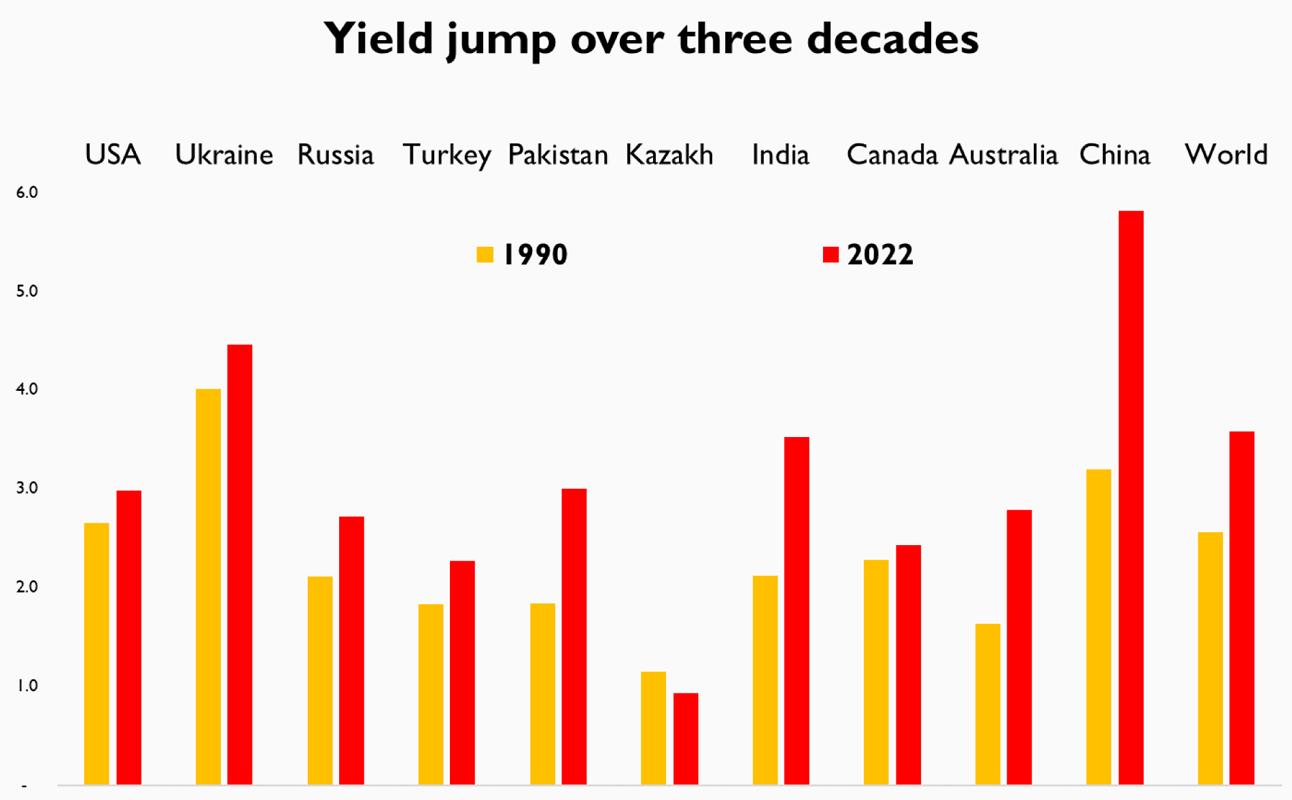Over the past three decades, the global economy has witnessed remarkable improvement in food output productivity. This quantum jump in world food output has in part been driven by the lifting of the Iron Curtain in 1991 and the fall of the Soviet Union. However, since the invasion of Ukraine by Russia began over the past year, the world at large – and, especially those in the Global South – have tasted a glimpse of what food affordability looked like 30 years ago, raising fears that food security has reversed gears. Are these fears justified?
Take wheat crop for example. Wheat based flour products – whether in the form of roti, bread, or pastas – have been the second biggest source of calories (after rice) for the global population since millennia, especially for societies in West Asia, Europe, and North America. Over the past three decades, world wheat output has increased by two hundred million metric tons (MMT), two-thirds of which has been contributed by just four Asian nations: India, Russia, China, and Pakistan.

Yet, compared to other cereal crops such as corn or rice, world wheat output has increased by just one-third since 1990. In contrast, world corn production has increased by 1.4 times during the same period, while rice output has increased by nearly half or 46 percent. In fact, on per capita basis, global wheat availability has declined from 111 kg per person in 1990 to under 100 kg per person in 2020, according to statistics from Oxford University database. Meanwhile, the area under wheat cultivation has stagnated globally, in fact declining by more than five percent during the thirty-year period. Does that mean the world is becoming increasingly wheat insecure, yet the world’s largest producers show little interest in taking steps to counteract this trend?
Short answer: no. That’s because the decline in per capita availability of wheat is directly correlated with the rise in per capita availability of animal-based proteins. Even as wheat production has lagged, global feed crop output has outshone, particularly soybean and corn whose output have increased by 2.5 times and 1.4 times during the thirty-year period, respectively. Higher feed crop production has in turn lowered the cost of production for dairy and meat-based proteins, raising their per capita availability and affordability. Fortunately, since human beings can only consume a finite number of calories, higher consumption of protein has in turn lowered the per capita demand (and thus, availability) of wheat based carbohydrates.

But that’s not necessarily true for populations in the developing world. In fact, long term food consumption trends suggest that as per capita income rises, societies graduate from more inferior grains such as rice to more balanced grains such as wheat. This trend has been particularly visible in East Asia, China and India, where wheat flour based products have gained in popularity in tandem with rising living standards – partly explaining why rise in wheat production in these regions over the last thirty years has been a conspicuous outlier to trends in global north. Meanwhile, the former Soviet Union nations of Russia and Ukraine have emerged as commodity exporting powerhouses, thanks to adoption of large scale mechanization in agricultural production.
There is, however, one other conspicuous exception, hiding in plain sight. When measured over last thirty years, Pakistan has been one of the top performers in raising wheat productivity among top ten wheat growing nations on the planet, even outpacing giants such as India, Russia, Canada, and USA. However, when measured over the past twenty – or even ten - years, Pakistan’s productivity performance drops to the last spot among world’s ten largest producers, possibly echoing larger trends of stagnating productivity across various sectors of the economy.

What happened? During these years - unlike other major producers-cum-consuming nations such as China and India - Pakistan failed to invest in raising productivity of its staple crop, resulting in severe crop yield stagnation. A concomitant failure to restrain population growth rate, along with a screeching halt in rise of per capita incomes, means that per capita demand for inferior caloric sources such as wheat remains unchanged. Meanwhile, Pakistan is one of the only nations where per capita availability of wheat over the last thirty years has dropped at a faster rate than the world average, dropping from 125 kg per capita at its peak during the 1990s, to just 108 kg per capita last year.
The world may not be wheat insecure after all, but Pakistan almost certainly is. To break out of this cycle, Pakistan will not only have to raise its domestic output by raising productivity, but also do all other things that rest of the world has done. Raise affordability of superior caloric sources such as animal-based protein, and also raise per capita incomes, so Pakistan can simply spend their way out of food insecurity. Unfortunately, in the short term, there may be no easy answers.





















Comments
Comments are closed.